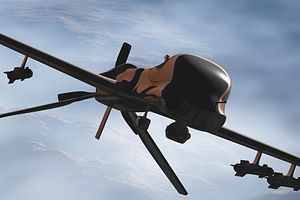Ethical arguments about the use of drones and how they fit within our values fail to consider the technological transformation that have allowed them to confound our expectations. Right now, Australia is engaged in a debate over the ethical implications of using armed drones. This debate has already formed into two sides. Each of these positions mirror the way in which the debate has unfolded within other countries and how those countries have deployed drones. Unfortunately, the nature of drones confounds our ethical measurements because we have few precedents to look to, aside from the international examples of other states. This relies on a prescriptive understanding of drones’ capability when their evolution to this point defies such an approach.
Drones were initially developed for reconnaissance, however the United States found an exploitable capability that could be rapidly adjusted within the contemporary battlespace. Australian analysts, by placing the use of drones within this context, fail to engage with the adjustable mindset that allowed those states that have deployed drones to adapt them to their needs. Basically, this means that commentators are buying into a debate, rather than understanding how technology is shaping the contemporary battlespace.
Behind the success of drones on the battlefield, lie a range of factors. Drones leveraged cheap platforms and emerging technology to create a highly adaptable capability that could easily be deployed in large numbers quickly. Australian commentators, however, treat drones as an end state, when in reality, the platform is anything but.
Going forward, we must first establish an understanding of three key advantages of drones. First, that drones are inexpensive when compared to alternative manned platforms. As such, the technology has the capacity to be an asymmetric advantage as the cost of increasing numbers is less than it is with other platforms. A Landing Helicopter Dock might provide a great advantage within its battlespace but it cannot be cheaply turned from one into ten thousand. Drone technology can find a point of success and be rapidly expanded. This factor in and of itself speaks to how this technology overruns our expectations.
Second, drones offer the ability to loiter over targets for longer than traditional aircraft. This allows drones to offer longer periods of support and surveillance over targets and to establish pattern-of-life information.
Finally, drones can be modified to suit user requirements. Not all drones are alike but the technology is easily adapted to suit the needs of defense. Just as drones switched rapidly from surveillance platforms to targeted killings the technology can be equally leveraged by the Australian Defense Force to meet identified capability shortfalls on shorter notice than is needed with other competing technologies. As such, taken together, many of the articles about the decision to acquire drones evaluates them through the lens of a single use.
Overall, none of the three factors discussed above makes the debate over employment of drones in target killings a necessary outgrowth of capability. As such, a large part of the debate presupposes this specific use and as such fails to consider the factors that made drones successful. Drones are employed outside of their standard mission profile by the United States in targeted killings because that is how they adapted the technology to the complex battlespace environment. This is not the only thing that the ADF would look for when deciding to acquire armed drones. The ADF, for its part, should be looking to leverage the underlying technology. None of the three factors discussed above necessitate the use of this capability in a campaign of targeted killing. Rather, they could be adapted to a more local context such as supporting troops or as a simple air support force multiplier.
By approaching this debate through the single lens of the targeted killing campaign we fail to holistically assess the capability offered by armed drones.
Robert Potter is a PhD Candidate at the University of Queensland. Previously he was a Visiting Scholar at Columbia University and took part in a research program in North Korea and China in 2013. Follow him on Twitter @rpotter_9. Chris Sheahan is a former Australian Army Officer who works as a security consultant for Ludus Resources Group. Follow him on Twitter @cj_sheahan.

































